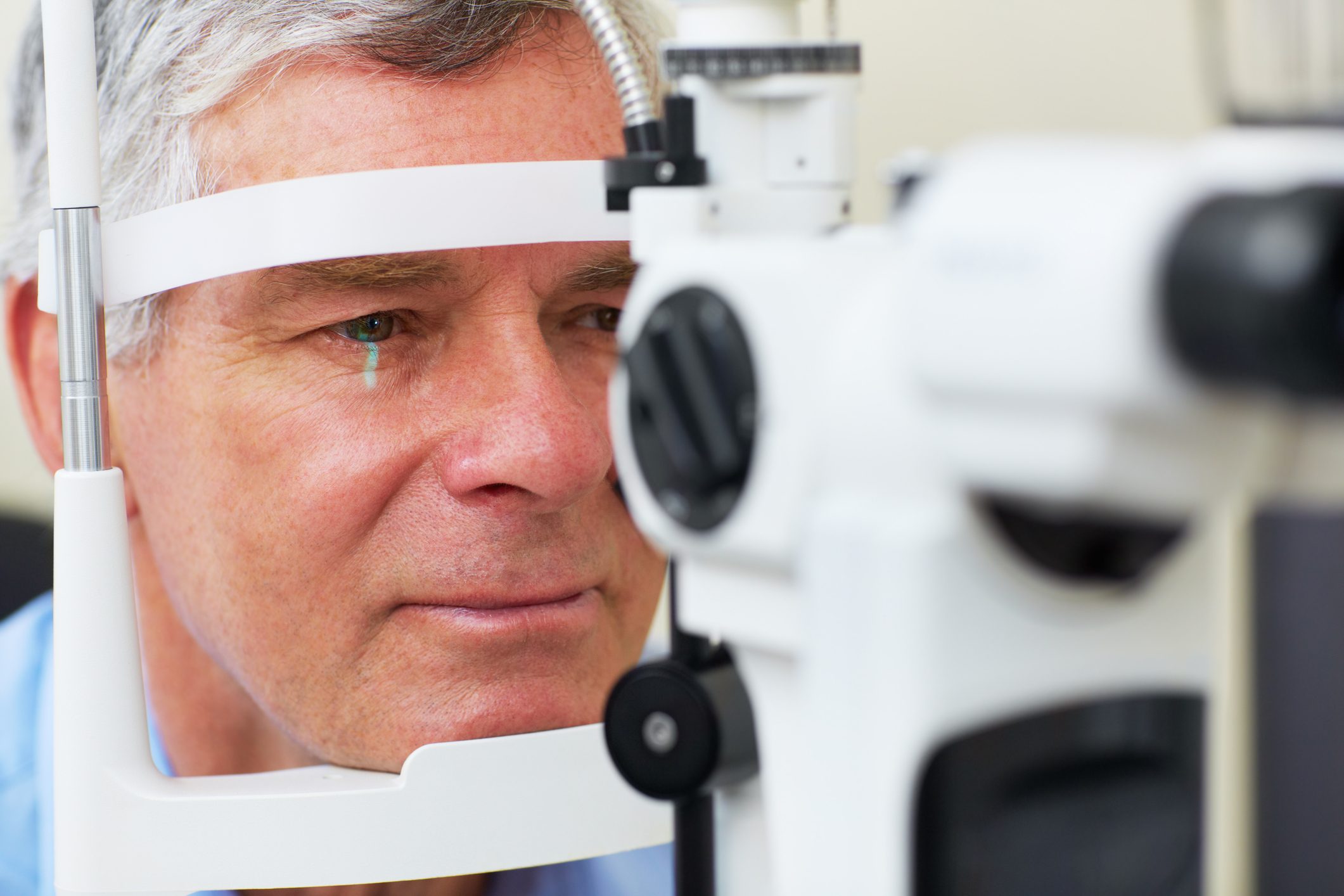Home » News and events »
Eye scans detect signs of Parkinson’s disease up to seven years before symptoms emerge

Research theme
People involved
Data, Diagnostics and Decision Tools Theme Lead
Markers showing the presence of Parkinson’s years before symptoms appear can be found in the eyes, new study proves.
A new collaborative study has identified markers indicating the presence of Parkinson’s disease in patients on average seven years before clinical presentation. This was the first time such markers were found several years before diagnosis, and these results were made possible by the largest study to date on retinal imaging in Parkinson’s disease.
The study, which was published yesterday in Neurology and involved NIHR Birmingham Biomedical Research Centre (BRC) Professor Alastair Denniston, used artificial intelligence (AI) to identify markers of Parkinson’s in eye scans. To achieve this, the team analysed the AlzEye database and then repeated the analysis using the broader UK Biobank database of healthy volunteers, which confirmed the discoveries. Using these two extensive databases enabled the researchers to identify subtle markers of Parkinson’s disease, despite its relatively low prevalence in the population (0.1-0.2%). Generation of the AlzEye dataset was enabled by INSIGHT, the world’s largest database of retinal images and associated clinical data.
“This work demonstrates the potential for eye data, harnessed by the technology to pick up signs and changes too subtle for humans to see. We can now detect very early signs of Parkinson’s, opening up new possibilities for treatment.”
– Professor Alastair Denniston
The eye as a window to systemic disease
This research builds on the emerging field of oculomics, where eye scans have previously revealed signs of other neurodegenerative conditions like Alzheimer’s, multiple sclerosis, and schizophrenia. Eye scans and eye data have also successfully indicated higher risks of high blood pressure, cardiovascular disease and strokes, and diabetes.
Oculomics uses machine learning to efficiently analyse large numbers of high-resolution images of the retina obtained through techniques like optical coherence tomography (OCT), a type of 3D scan used routinely in eye care. In less than a minute, OCT provides a detailed cross-section of the retina, allowing researchers to examine layers of cells beneath the skin’s surface with incredible precision – down to a thousandth of a millimetre – in a non-invasive way. This allows not only to monitor eye health, but to also gain valuable insights into the overall health of the whole body.
Leveraging the power of partnership
This project was led by Siegfried Wagner and Pearse Keane of Moorfields Eye Hospital and UCL Institute of Ophthalmology. It was the result of a research collaboration between the NIHR (National Institute of Health and Social Care) Biomedical Research Centres at Moorfields Eye Hospital, University Hospital Birmingham, Great Ormond Street Hospital, Oxford University Hospitals and University College Hospital London.
Study author Alastair Denniston, consultant ophthalmologist at University Hospitals Birmingham, Professor at the University of Birmingham’s Institute of Inflammation and Ageing, co-lead of the NIHR Birmingham BRC Data, Diagnostics and Decision Tools research theme, and part of the Biomedical Research Centre for Ophthalmology at Moorfields Eye Hospital/UCL said: “This work demonstrates the potential for eye data, harnessed by the technology to pick up signs and changes too subtle for humans to see. We can now detect very early signs of Parkinson’s, opening up new possibilities for treatment.”
Siegfried Wagner, clinical research fellow at Moorfields Eye Hospital, UCL Institute of Ophthalmology researcher and principal investigator for this study, added: “I continue to be amazed by what we can discover through eye scans. While we are not yet ready to predict whether an individual will develop Parkinson’s, we hope that this method could soon become a pre-screening tool for people at risk of disease. Finding signs of a number of diseases before symptoms emerge means that, in the future, people could have the time to make lifestyle changes to prevent some conditions arising, and clinicians could delay the onset and impact of lifechanging neurodegenerative disorders.”
-
Notes for editors
For further information, please contact moorfields.pressoffice@nhs.net
Further technical and background information on the study
Parkinson disease’s is a progressive neurological condition, characterised by a reduction of dopamine, and post-mortem examination of patients with Parkinson’s disease has found differences in the INL (inner nuclear layer) of the retina. Previous studies using OCT scans have found potential morphological abnormalities associated with the disease, but with inconsistencies.
This study confirmed previous reports of a significantly thinner GCIPL (ganglion cell–inner plexiform layer), while for the first time finding a thinner INL. It further found that a reduced thickness of these layers was associated with increased risk of developing Parkinson’s disease, beyond that conferred by other factors or comorbidities.
Future studies are needed to determine whether progression of GCIPL atrophy is driven by brain changes in Parkinson’s disease, or if INL thinning precedes GCIPL atrophy. Exploring this could help explain the mechanism and determine whether retinal imaging could support the diagnosis, prognosis, and complex management of patients affected by Parkinson disease.
The study also did not have detailed clinical information about Parkinson’s disease status in the patients (exact diagnosis date, treatment patterns and current therapy), which could have related retinal changes to disease duration or progression.
About Moorfields Eye Hospital NHS Foundation Trust
Moorfields Eye Hospital NHS Foundation Trust is one of the leading providers of eye health services in the UK and a world class centre of excellence for ophthalmic research and education. Our main focus is the treatment and care of NHS patients with a wide range of eye problems, from common complaints to rare conditions that require treatment not available elsewhere in the UK. Our unique patient case-mix and the number of people we treat mean that our clinicians have expertise in discrete ophthalmic sub-specialties.
We treat people in 23 locations in and around London, the south east and Bedford, enabling us to provide expert treatment closer to patients’ homes. We also operate commercial divisions that provide care to private patients in both London and the Middle East.
With our academic partners at the UCL Institute of Ophthalmology, Moorfields is recognised as a leading centre of excellence in eye and vision research. Together we form one of the largest ophthalmic research sites in the world, with the largest patient population in Europe or the USA. We publish more scientific papers than any other eye and vision research site and have an extensive joint research portfolio.
About UCL Institute of Ophthalmology
UCL Institute of Ophthalmology is one of the foremost eye and vision research institutes in the world. It operates at the cutting edge of translational research, delivering new therapies, diagnostic tools and preventive measures to patients suffering from visual impairment or blinding conditions. The combination of the Institute’s research resource with Moorfields Eye Hospital, which has the largest ophthalmic patient population in the western world, opens the way for further advances in vision research. Close collaboration with other academic partners and with industry extends its impact. The Institute has been named as the best place to study ophthalmology in the 2017 Centre for World University Rankings (CWUR). For further information, please visit www.ucl.ac.uk/ioo.
About UCL
UCL is a diverse global community of world-class academics, students, industry links, external partners, and alumni. Our powerful collective of individuals and institutions work together to explore new possibilities.
Since 1826, we have championed independent thought by attracting and nurturing the world’s best minds. Our community of more than 50,000 students from 150 countries and over 16,000 staff pursues academic excellence, breaks boundaries and makes a positive impact on real world problems.
We are consistently ranked among the top 10 universities in the world and are one of only a handful of institutions rated as having the strongest academic reputation and the broadest research impact.
We have a progressive and integrated approach to our teaching and research – championing innovation, creativity and cross-disciplinary working. We teach our students how to think, not what to think, and see them as partners, collaborators and contributors.
For almost 200 years, we are proud to have opened higher education to students from a wide range of backgrounds and to change the way we create and share knowledge.
We were the first in England to welcome women to university education and that courageous attitude and disruptive spirit is still alive today. We are UCL.
www.ucl.ac.uk | Follow @uclnews on Twitter | Read news at www.ucl.ac.uk/news/ | Listen to UCL podcasts on SoundCloud | Find out what’s on at UCL Minds
About The National Institute for Health and Care Research
The mission of the National Institute for Health and Care Research (NIHR) is to improve the health and wealth of the nation through research. We do this by:
- Funding high quality, timely research that benefits the NHS, public health and social care;
- Investing in world-class expertise, facilities and a skilled delivery workforce to translate discoveries into improved treatments and services;
- Partnering with patients, service users, carers and communities, improving the relevance, quality and impact of our research;
- Attracting, training and supporting the best researchers to tackle complex health and social care challenges;
- Collaborating with other public funders, charities and industry to help shape a cohesive and globally competitive research system;
- Funding applied global health research and training to meet the needs of the poorest people in low and middle income countries.
NIHR is funded by the Department of Health and Social Care. Its work in low and middle income countries is principally funded through UK Aid from the UK government.
About NIHR Biomedical Research Centre at Moorfields Eye Hospital NHS Foundation Trust and UCL Institute of Ophthalmology
NIHR Moorfields BRC is an internationally renowned partnership between Moorfields Eye Hospital NHS Foundation Trust and UCL Institute of Ophthalmology, ranked number one in the world for ophthalmology research. The BRC was first established in April 2007 and is now in the fourth five-year term to support research designed to take advances in basic medical research from the laboratory to the clinic. The centre’s broad spectrum of research into eye disease enables patients to benefit more quickly from world-class scientific breakthroughs, treatments and diagnostics, and has demonstrated a wider reach into other health conditions through digital technology and advanced therapies. For further information, please visit www.moorfieldsbrc.nihr.ac.uk/
About the INSIGHT Data Hub
INSIGHT is a health data research hub focused on eye health and associated conditions. It is one of seven hubs set up by the UK government to speed up research for new medicines and treatments, support quicker diagnoses and potentially save lives.
INSIGHT is an NHS-led partnership set up to make routinely collected eye data available for health research; to improve healthcare by making it simpler for researchers to use large, anonymised sets of patient data in a safe and ethical way.
Together with partners from the NHS, academia, industry and the charity sector, INSIGHT is working to transform the way diseases are diagnosed, treated and managed in the UK and beyond.



